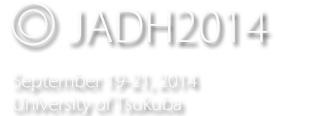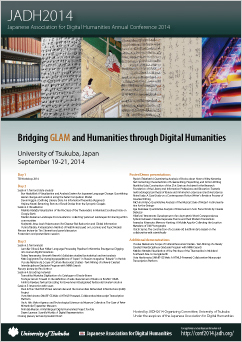Poster session 8
The Construction of Accurate Old Landform Data based on the Collaborative Edit Scientifically
- Yoichi Seino (National Institutes for the Humanities)
- Mamiko Mataza (Ritsumeikan University)
- Takafusa Iizuka (Ritsumeikan University)
The old geographical information is necessary for not only the academic purpose but also disaster management or social education etc. So, to create the old geographical information is very important but that is not suitable for the business because it is not able to use for the routing or geocoding in our contemporary life. Therefore this information should be created according to the academic purpose at first and then it will be published. On the other hand, to create the large and wide geographical information requires the much time or cost as for the personal activity. In this paper, we consider the possibility of achievement about the above issues by setting up the place to create the old geographical data collaboratively and to discuss the authenticity of that data through the Internet and the Web.
We mentioned the importance of the creation about the digital old terrain database before (Seino 2013.) At that time, we refer to the importance of the raster digital elevation data. But the raster data tend to be the large file size, so it is difficult to prepare the server resources or to overcome some technical issues.
Therefore, we attempt to create the shoreline vector data as a fundamental data for creating the old terrain data. To digitize the area under the water at that time and now emerged is usable to consider various analyses on the GIS. The vector data have many advantages. One is the vector data are light and small file size, and the other is easy to convert the human-readable text data, so it is easy to control on the version control system (VCS.)
OpenStreetMap (OSM) is the most popular Volunteered Geographic Information (VGI) system in the world. OSM build a large community and a lot of people join it. OSM's number of participants is an advantage rather than other projects. However, OSM is the map that is hoped to use by ordinary people living now and the project focuses on the current geographic information, so we are not able to use this system to create the old geographical data. In addition, OSM corresponds the revision control, showing the existing data (XML format) or downloading the data but it is difficult to view the raw data because OSM uses the Relational Database Management System (RDBMS) and OSM only supports vector data so we are not able to use raster data if we want to manage the raster data in the future. In the aspect of user management, OSM does not avoid the authentic issue or edit wars because OSM is open to everyone and not only to the researchers.
The data that we created are the old bankline of the Lake Biwa based on the maps published in the Meiji and Taisho period. However, at least, we recognize that it is necessary to digitize the oldest maps surveyed by the modern style and this information is the fundamental data to restore or to simulate the premodern terrain.
We use the “GitHub” which is the source code repository and hosting facility based on the VCS software “Git” and “geojson.io” which is hosted by the MapBox as the extension service of the GitHub to create, change, and publish the geographic information.
The significant feature of the VCS is the strong revision control function. This function records who committed the shared data and if you want, you are able to rollback. In the many VCS softwares, the Git has an advantage that it is easy to “fork” and “merge” than other VCS softwares. This advantage makes us to set the Master and the branch line easily and each member can work at their own pace, and then if they need, they are able to merge to the master. These functions of the VCS is very efficient in the academic collaboration. Each member is able to work keeping their individual opinion.
These data that we created help restoring the premodern bankline of the Lake Biwa. We try to gather the other old historical resources about the premodern reclamation or sedimentation and consider the older bankline as the future tasks. These tasks must to be discussed from various aspects. At that time, this platform will be efficient for the discussions. The substantial discussions make the data more authentic like the peer-reviewed research production in the academic society.
- Keywords
- GIS (Geographic Information System), collaborative work, vector data, VCS (Version Control System), repository
Reference
- Seino, Yoichi: “The possibility about the collaborative creation of wide area ancient digital terrain database,” The Second International Conference of Asian Network for GIS-based Historical Studies (ANGIS), held at Clock Tower Centennial Hall, Kyoto University, Kyoto, Japan (2013).

